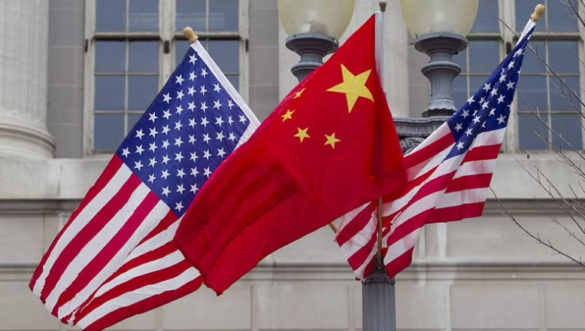
How CIA & Chinese PLA joined hands in secret Cold War op to snoop on Soviet Union nukes
In a stunning revelation, journalist Jane Perlez has brought to light new details on Project Chestnut — an extraordinary Cold War operation that brought together the CIA and the PLA.
New Delhi: Every fortnight, in the summer of 1989, People’s Liberation Army (PLA) trucks trundled out of a dust-blown base near Qitai in Xinjiang, beginning a 3,000-kilometre journey to Beijing. Inside, there were hundreds of magnetic-tape spools, loaded with intercepted radio signals and seismic information — all headed to Albuquerque in the United States.
Analysts there used the data to piece together the state of the erstwhile Soviet Union’s nuclear-missile programme.
Earlier that year, China had massacred hundreds — perhaps thousands — of protesters at Tiananmen Square, leading the United States to clamp an embargo on military sales and cut back diplomatic contact. Amid furious public posturing, both the Central Intelligence Agency (CIA) and the PLA continued to cooperate quietly.
In a stunning revelation, journalist Jane Perlez has now brought to light new details on Project Chestnut — an extraordinary Cold War operation that brought together the CIA and the PLA.
In 1979, Perlez reports, China’s new leader, Deng Xiaoping, made a secret, late-night visit to the CIA’s headquarters in Washington to review exactly where Project Chestnut’s stations would be located.
Even when nation states appear to be in implacable opposition, the story shows, intelligence services can still cooperate against common adversaries.
Project Chestnut
The story of Project Chestnut dates back to the autumn of 1970 when, declassified documents show, former US secretary of state Henry Kissinger began exploring opening dialogue with China through Pakistan’s military ruler, General Yahya Khan. The conversation led on, in the summer of 1971, to a now-famous secret visit by Kissinger to Beijing.
A formal visit by President Richard Nixon followed in 1972 — just a few years after American generals had drawn up nuclear war plans to obliterate China as a “viable society”.
Late in 1972, a new Beijing-Washington military back-channel built up, involving diplomats from China’s mission to the United Nations, and the Mandarin-speaking scholar Michael Pillsbury.
In 1975, Pillsbury published an article in the magazine Foreign Policy — in essence, a declassified version of his military research and memos to the government — calling for Washington to “reject the current blind public policy of blanket prohibition of defence technology transfer and intelligence sharing with Peking [Beijing]”.
Kissinger, that year, acted on Pillsbury’s advice, by persuading President Gerald Ford to make the United Kingdom sell advanced jet engine technology to China. The next year, the US itself sold two advanced computers, with military applications, to China.
Then, in 1979, after the US lost its espionage outposts in Iran because of the revolution in that country, it went to China with the idea of establishing spy stations there to monitor the Soviet missile programme.
China agreed — but only after formal diplomatic relations were established. The night visit Deng made to CIA headquarters came in the course of his visit to the US to mark the resumption of diplomatic relations.
The making of new best friends
Final arrangements were made to send US technicians to set up and operate the facilities when a little-known senator — Joe Biden — met Deng in 1979, the Washington Post reported, in one of the few public accounts of Project Chestnut.
“American technicians would fly to Ürümqi, the capital of Xinjiang province,” Perlez writes, “before boarding a tiny plane to a little airport near the Soviet border, followed by a drive on a bumpy, country road through the mountainous desert, before they finally reached the remote spy stations.”
“The Americans almost always went in pairs in part because the stations were so isolated, the CIA worried about their mental health if they went alone. The spy stations were stocked with beer and Spam, a favourite snack of the Chinese posted there.”
America’s new listening stations at Qitai and Korla gathered reams of data on Soviet missile tests in Central Asia — most notably at Tyuratam and Saryshagan, in Kazakhstan. The quality of data gathered from these tests is said to be superior to that generated from Iran, because of geographical proximity.
For years afterwards, intelligence cooperation between the US and China continued to flower. Among other things, the PLA supplied Chinese-made weapons to the CIA, for the anti-Soviet Union mujahideen (Islamic guerrillas) in Afghanistan.
The two Cold War partners shared the threat from Soviet Union, but after the USSR collapsed, they turned bitter enemies. Eighteen CIA assets in China were reported to have been hunted down and killed or imprisoned by Chinese counter-intelligence from 2010 to 2012 alone. PLA-funded hacking networks have successfully targeted the US on several occasions.
America, in turn, has stepped up the resources it spends on targeting China — but is reported to be frustrated by the lack of success it has had in penetrating the country’s top leadership.
(Edited by Manoj Ramachandran)
Source: https://theprint.in/world/how-cia-chinese-pla-joined-hands-in-secret-cold-war-op-to-snoop-on-soviet-union-nukes/844469/